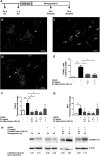Extracellular Vesicles Derived from Wharton's Jelly Mesenchymal Stem Cells Prevent and Resolve Programmed Cell Death Mediated by Perinatal Hypoxia-Ischemia in Neuronal Cells
- PMID: 29562785
- PMCID: PMC6434490
- DOI: 10.1177/0963689717738256
Extracellular Vesicles Derived from Wharton's Jelly Mesenchymal Stem Cells Prevent and Resolve Programmed Cell Death Mediated by Perinatal Hypoxia-Ischemia in Neuronal Cells
Abstract
Hypoxic-ischemic (HI) insult in the perinatal phase harbors a high risk of encephalopathy in the neonate. Brain cells undergo apoptosis, initiating neurodegeneration. So far, therapeutic approaches such as cooling remain limited. Transplantation of mesenchymal stem cells (MSCs) exhibits therapeutic success despite the short-time survival in the host brain, providing strong evidence that their beneficial effects are largely based on secreted factors, including extracellular vesicles (EVs). The aim of this study was to investigate the effects of human Wharton's jelly MSC (hWJ-MSC)-derived EVs on neuroprotection and neuroregeneration, using an in vitro model of oxygen-glucose deprivation/reoxygenation (OGD/R) mimicking HI injury in the mouse neuroblastoma cell line neuro2a (N2a). hWJ-MSC-derived EVs were isolated from cell culture supernatants by multistep centrifugation and identified by endosomal marker expression and electron microscopy. OGD/R significantly increased DNA fragmentation and caspase 3 ( Casp3) transcription in N2a cells relative to undamaged cells. OGD/R-mediated DNA fragmentation and Casp3 expression could be prevented as well as resolved by the addition of hWJ-MSC-derived EV before and after OGD, respectively. hWJ-MSC-derived EV also tended to increase the phosphorylation of the B cell lymphoma 2 (Bcl2) family member Bcl-2-antagonist of cell death (BAD) in N2a cells, when added prior or post OGD, thereby inactivating the proapoptotic function of BAD. Fluorescence confocal microscopy revealed the close localization of hWJ-MSC-derived EVs to the nuclei of N2a cells. Furthermore, EVs released their RNA content into the cells. The expression levels of the microRNAs (miRs) let-7a and let-7e, known regulators of Casp3, were inversely correlated to Casp3. Our data suggest that hWJ-MSC-derived EVs have the potential to prevent and resolve HI-induced apoptosis in neuronal cells in the immature neonatal brain. Their antiapoptotic effect seems to be mediated by the transfer of EV-derived let-7-5p miR.
Keywords: apoptosis; extracellular vesicles (EVs); let-7-5p; neuroprotection; neuroregeneration; oxygen–glucose deprivation/reoxygenation (OGD/R).
Conflict of interest statement
Figures




Similar articles
-
Extracellular Vesicles from Wharton's Jelly Mesenchymal Stem Cells Suppress CD4 Expressing T Cells Through Transforming Growth Factor Beta and Adenosine Signaling in a Canine Model.Stem Cells Dev. 2019 Feb 1;28(3):212-226. doi: 10.1089/scd.2018.0097. Epub 2019 Jan 14. Stem Cells Dev. 2019. PMID: 30412034
-
Extracellular Vesicle-Derived microRNAs of Human Wharton's Jelly Mesenchymal Stromal Cells May Activate Endogenous VEGF-A to Promote Angiogenesis.Int J Mol Sci. 2021 Feb 19;22(4):2045. doi: 10.3390/ijms22042045. Int J Mol Sci. 2021. PMID: 33669517 Free PMC article.
-
Extracellular vesicles derived from human Wharton's jelly mesenchymal stem cells protect hippocampal neurons from oxidative stress and synapse damage induced by amyloid-β oligomers.Stem Cell Res Ther. 2019 Nov 20;10(1):332. doi: 10.1186/s13287-019-1432-5. Stem Cell Res Ther. 2019. PMID: 31747944 Free PMC article.
-
Perspectives for Future Use of Extracellular Vesicles from Umbilical Cord- and Adipose Tissue-Derived Mesenchymal Stem/Stromal Cells in Regenerative Therapies-Synthetic Review.Int J Mol Sci. 2020 Jan 25;21(3):799. doi: 10.3390/ijms21030799. Int J Mol Sci. 2020. PMID: 31991836 Free PMC article. Review.
-
Wharton's Jelly Mesenchymal Stem Cell-Derived Extracellular Vesicles Reduce SARS-CoV2-Induced Inflammatory Cytokines Under High Glucose and Uremic Toxin Conditions.Stem Cells Dev. 2021 Aug 1;30(15):758-772. doi: 10.1089/scd.2021.0065. Epub 2021 Jul 5. Stem Cells Dev. 2021. PMID: 34074129 Free PMC article.
Cited by
-
Biomaterials functionalized with MSC secreted extracellular vesicles and soluble factors for tissue regeneration.Adv Funct Mater. 2020 Sep 10;30(37):1909125. doi: 10.1002/adfm.201909125. Epub 2020 Mar 11. Adv Funct Mater. 2020. PMID: 32952493 Free PMC article.
-
RNA delivery by extracellular vesicles in mammalian cells and its applications.Nat Rev Mol Cell Biol. 2020 Oct;21(10):585-606. doi: 10.1038/s41580-020-0251-y. Epub 2020 May 26. Nat Rev Mol Cell Biol. 2020. PMID: 32457507 Free PMC article. Review.
-
Mesenchymal Stromal/Stem Cell Extracellular Vesicles and Perinatal Injury: One Formula for Many Diseases.Stem Cells. 2022 Nov 29;40(11):991-1007. doi: 10.1093/stmcls/sxac062. Stem Cells. 2022. PMID: 36044737 Free PMC article. Review.
-
Extracellular vesicles derived from different sources of mesenchymal stem cells: therapeutic effects and translational potential.Cell Biosci. 2020 May 24;10:69. doi: 10.1186/s13578-020-00427-x. eCollection 2020. Cell Biosci. 2020. PMID: 32483483 Free PMC article. Review.
-
Wharton's jelly mesenchymal stem cells: a concise review of their secretome and prospective clinical applications.Front Cell Dev Biol. 2023 Jun 27;11:1211217. doi: 10.3389/fcell.2023.1211217. eCollection 2023. Front Cell Dev Biol. 2023. PMID: 37440921 Free PMC article. Review.
References
-
- Johnston MV, Trescher WH, Ishida A, Nakajima W. Neurobiology of hypoxic-ischemic injury in the developing brain. Pediatric Res. 2001;49(6):735–741. - PubMed
-
- Vannucci SJ, Hagberg H. Hypoxia-ischemia in the immature brain. J Exp Biol. 2004;207(Pt 18):3149–3154. - PubMed
-
- Zhu C, Wang X, Xu F, Bahr BA, Shibata M, Uchiyama Y, Hagberg H, Blomgren K. The influence of age on apoptotic and other mechanisms of cell death after cerebral hypoxia-ischemia. Cell Death Differ. 2005;12(2):162–176. - PubMed
Publication types
MeSH terms
Substances
LinkOut - more resources
Full Text Sources
Other Literature Sources
Research Materials

